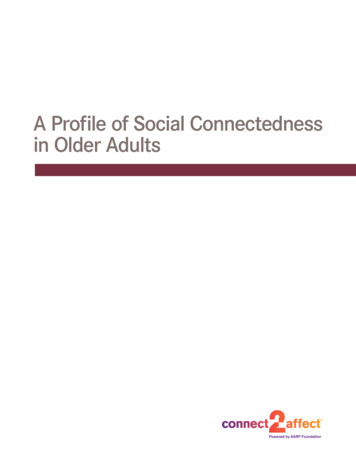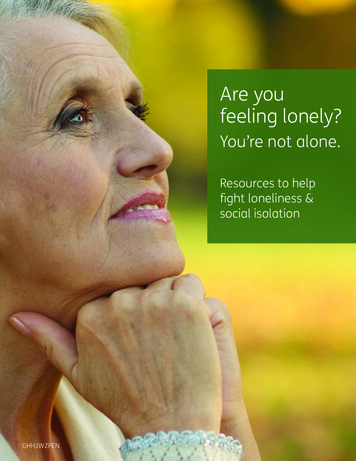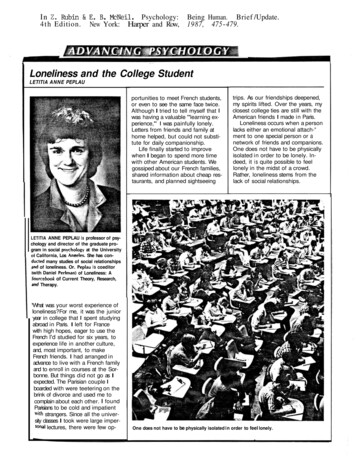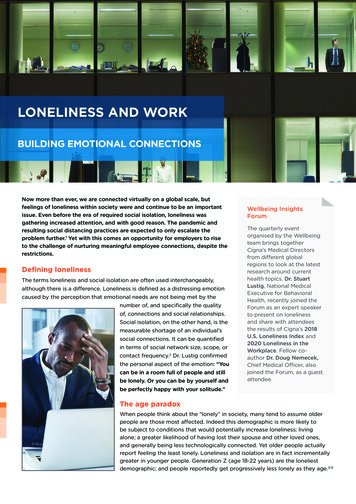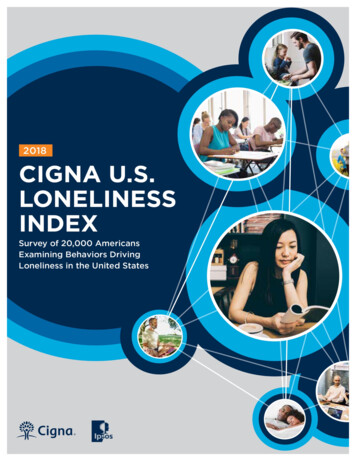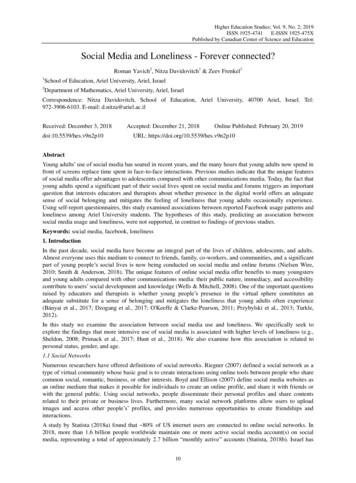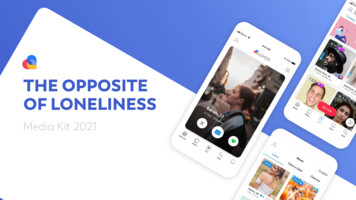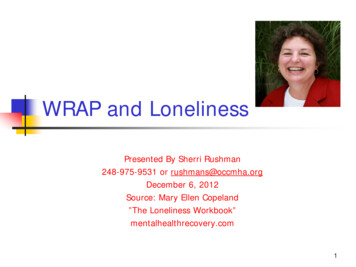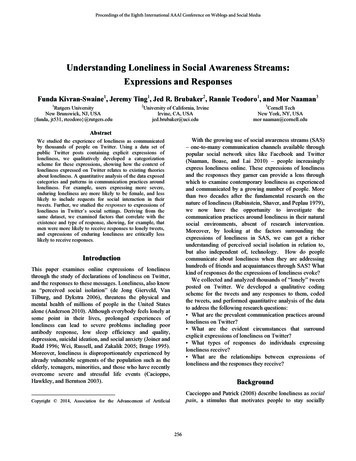
Transcription
Proceedings of the Eighth International AAAI Conference on Weblogs and Social MediaUnderstanding Loneliness in Social Awareness Streams:Expressions and ResponsesFunda Kivran-Swaine1, Jeremy Ting1, Jed R. Brubaker2, Rannie Teodoro1, and Mor Naaman31Rutgers UniversityNew Brunswick, NJ, USA{funda, jt531, rteodoro}@rutgers.edu2University of California, IrvineIrvine, CA, USAjed.brubaker@uci.edu3Cornell TechNew York, NY, USAmor naaman@cornell.eduAbstractWith the growing use of social awareness streams (SAS)– one-to-many communication channels available throughpopular social network sites like Facebook and Twitter(Naaman, Boase, and Lai 2010) – people increasinglyexpress loneliness online. These expressions of lonelinessand the responses they garner can provide a lens throughwhich to examine contemporary loneliness as experiencedand communicated by a growing number of people. Morethan two decades after the fundamental research on thenature of loneliness (Rubinstein, Shaver, and Peplau 1979),we now have the opportunity to investigate thecommunication practices around loneliness in their naturalsocial environments, absent of research intervention.Moreover, by looking at the factors surrounding theexpressions of loneliness in SAS, we can get a richerunderstanding of perceived social isolation in relation to,but also independent of, technology. How do peoplecommunicate about loneliness when they are addressinghundreds of friends and acquaintances through SAS? Whatkind of responses do the expressions of loneliness evoke?We collected and analyzed thousands of “lonely” tweetsposted on Twitter. We developed a qualitative codingscheme for the tweets and any responses to them, codedthe tweets, and performed quantitative analysis of the datato address the following research questions: What are the prevalent communication practices aroundloneliness on Twitter? What are the evident circumstances that surroundexplicit expressions of loneliness on Twitter? What types of responses do individuals expressingloneliness receive? What are the relationships between expressions ofloneliness and the responses they receive?We studied the experience of loneliness as communicatedby thousands of people on Twitter. Using a data set ofpublic Twitter posts containing explicit expressions ofloneliness, we qualitatively developed a categorizationscheme for these expressions, showing how the context ofloneliness expressed on Twitter relates to existing theoriesabout loneliness. A quantitative analysis of the data exposedcategories and patterns in communication practices aroundloneliness. For example, users expressing more severe,enduring loneliness are more likely to be female, and lesslikely to include requests for social interaction in theirtweets. Further, we studied the responses to expressions ofloneliness in Twitter’s social settings. Deriving from thesame dataset, we examined factors that correlate with theexistence and type of response, showing, for example, thatmen were more likely to receive responses to lonely tweets,and expressions of enduring loneliness are critically lesslikely to receive responses.IntroductionThis paper examines online expressions of lonelinessthrough the study of declarations of loneliness on Twitter,and the responses to these messages. Loneliness, also knowas “perceived social isolation” (de Jong Gierveld, VanTilburg, and Dykstra 2006), threatens the physical andmental health of millions of people in the United Statesalone (Anderson 2010). Although everybody feels lonely atsome point in their lives, prolonged experiences ofloneliness can lead to severe problems including poorantibody response, low sleep efficiency and quality,depression, suicidal ideation, and social anxiety (Joiner andRudd 1996; Wei, Russell, and Zakalik 2005; Brage 1995).Moreover, loneliness is disproportionately experienced byalready vulnerable segments of the population such as theelderly, teenagers, minorities, and those who have recentlyovercome severe and stressful life events (Cacioppo,Hawkley, and Berntson 2003).BackgroundCaccioppo and Patrick (2008) describe loneliness as socialpain, a stimulus that motivates people to stay sociallyCopyright 2014, Association for the Advancement of Artificial256
connected. People crave to be socially connected - in factbelonging theory suggests that the need to belong is likelyan evolutionary trait (Baumeister and Leary 1995). Whenpeople feel they are deprived of satisfactory social bonds,they experience loneliness (Perlman and Peplau 1981).Loneliness ensues from interplay of personal attributes(e.g., attributional styles, gender, age), situational factors(e.g., exposure to stressful life events), and culturalcircumstances (Weiss 1982). Not only do people differ inways they perceive and evaluate their relationships, butalso their standards for what their relationships should belike, can be shaped by the cultural settings they live in.The experience of loneliness is idiosyncratic. People’sindividual descriptions of how they feel when theyexperience loneliness, as well as their reactions toloneliness, differ greatly. Rubenstein and Shaver (1979)cluster experiences of loneliness into four categories:impatient boredom, desperation, depression, and selfdeprecation. Impatient boredom describes a mildexperience of loneliness manifested by feelings of unease,anger, and the inability to concentrate. Desperation, themost common, is a moderate level of loneliness that caninclude feelings of panic, helplessness, and abandonment.Finally, prolonged and severe experiences of loneliness aredescribed as either depression (e.g., feelings ofmelancholy, isolation, emptiness) or self-deprecation (e.g.,feeling unattractive, down on self, stupid, ashamed).People experiencing mild forms of loneliness often resortto active solitude (e.g., self-fulfilling activ- ities likestudying, working, engaging in hobbies) or social contact(i.e., communication in face-to-face or mediated settings)(Rubinstein, Shaver, and Peplau 1979). When theexperience of loneliness is severe, people tend to fall intosad passivity, a group of activities detrimental to one’shealth such as overeating, crying, or taking tranquilizers.As put forth by several existing studies, lonely peopletypically exhibit low self-disclosure in interpersonalsettings (Schwab et al. 1998; Bell 1985; Gerson andPerlman 1979) and are less likely to self-disclose to bothstrangers and friends (Schwab et al. 1998). Emotional selfdisclosure, a strong predictor for perception of intimacy ininterpersonal relationships (Laurenceau, Barrett, andPietromonaco 1998) is negatively correlated withloneliness (Solano, Batten, and Parish 1982).The low self-disclosure of lonely people extends beyondtraditional communication settings and has been observedin computer-mediated environments as well. Burke et al.found that on Facebook, there was a significant negativerelationship between high levels of loneliness and people’stendency to participate in directed communication (e.g.messages, Wall posts) (Burke, Marlow, and Lento 2010).A more recent study by Jin found that lonely peoplereportedly engaged in positive self-disclosure on Facebookless than non-lonely people, and also reported to self-disclose negative events and thoughts more than nonlonely people (Jin 2013).Is social media making us lonely? On one side of thedebate, Turkle argues that with connectedness, made easierby today’s technology, people are sacrificing quality intheir interactions for quantity. People are alwaysconnected, but their relationships lack intimacy and peoplesubsequently experience loneliness. Moreover, as peoplebecome accustomed to constant connection, they strugglewith solitude and desperately look for signals ofcommunication (Turkle 2012). On the other hand,quantitative research on the field is inconclusive about therelationship between loneliness and Internet use. AmichaiHamburger Ben-Artzi (2003) suggest that people who arelonely spend more time on the Internet, but the direction ofthe relationship is the opposite of what is hinted to, atTurkle’s work, increased loneliness leading to more timespent on the Internet. The results of the study by Moodyreveal that the more frequently people use the Internet, themore satisfied they are with the broader social networkthey have. However, at the same time, they may also feellonelier due to lack of an intimate relationship, possiblywith a romantic partner (Moody 2001). In short, therelationship between loneliness and quantity of Internetuse, when found, is complicated. Frequency of Internet usemay correlate with loneliness, but loneliness causesincreased Internet use, not visa versa.People self-disclose about their emotional experiences insocial media (Kamvar and Harris 2009), and particularly inSAS (Brubaker et al. 2012). There has been recent interestin tying the use of emotion-laden language, an indicator ofemotional self-disclosure to characteristics of individuals(Kamvar and Harris 2009), to their psychosocialcircumstances (Brubaker et al. 2012) and well-being (DeChoudhury et al. 2013; De Choudhury, Counts, andHorvitz 2013). To our knowledge, the only work that hasinvestigated the linguistic correlates correlation of onlineexpressions of loneliness, is from Kamvar and Harris(2009), which highlights that loneliness was mostcommonly expressed in conjunction with being unloved,depressed, bored, and friendless and was also more readilyexpressed by women than men, in blog posts.Methodology and DatasetOur study is based on large-scale analysis of public statusposts expressing loneliness collected from Twitter(hereafter ”lonely tweets”), and the public responses tothose tweets, on Twitter. We developed a qualitativecoding scheme for the tweets and the replies, coded tweetsaccording to that scheme, and used Mechanical Turk tolabel the users posting the tweet as female or male. In thissection, we provide more details on the basic dataset257
construction and then expand on the qualitative codingprocess and resulting coding nglyrics.com), or to a YouTube video, we classified thetweet as a lyric. After the development of the detector,authors took a random sample of 200 classified tweets,extensively searched if whether it contained a lyric, andcompared their results with the classifier. The accuracy ofthe lyric detection is estimated at 87%, with 9% falsepositives, and 4% false negatives. After this step for lyricdetection, our final dataset consisted of 10,380 posts, with10,378 unique users, 70% of whom were female.DatasetWe collected two samples from Twitter, a coding datasetin March 2013, and a final dataset in November 2013.The coding dataset was used to develop the qualitativecoding scheme for lonely tweets. For this dataset, wecrawled Twitter for posts containing the phrase ”I’m solonely” using the Twitter streaming API and collected2000 tweets that were used for the construction of thecoding scheme described in the next section.For the final dataset, we collected a sample of 12,975English Twitter posts (tweets) that explicitly expressedloneliness using the Twitter Streaming API betweenNovember 15 and November 29 of 2013. The lonely tweetswe collected contained one or more phrases that expressedfeelings of perceived social isolation as described by(Russell, Peplau, and Ferguson 1978). The phrasesincluded: ”I’m so lonely,” ”I feel left out,” and ”I feelisolated.” Retweets were excluded.Next, we used the Twitter API to get additionalinformation for each of the 12,622 lonely tweet authors.This data included publicly available profile information,usage metrics, and the Twitter activity surrounding eachperson’s lonely tweet. Profile information was collectedfrom their Twitter profile. Usage metrics included theuser’s total number of the tweets, number of followers andfollowees, as well as the average number of replies theyreceive per tweet. We also collected the user’s tweetsbefore and after the lonely tweet was posted, as well as anypublic replies to the lonely tweet.Finally, we labeled the gender of each person in ourdataset using Amazon Mechanical Turk (AMT). The AMTtask provided AMT workers with information about eachuser, including their profile picture, name, and Twitterusername. The workers were asked to label the gender foreach user. Represented gender of each user was labeled byan AMT worker, as either “male”, “female”, or“unknown”. To verify the accuracy of gender coding byAMT workers, one author coded the gender for 200randomly selected users, showing 85.5% accuracy.However, preliminary examination of the final datasetshowed that a noticeable amount of the tweets gatheredwere not authentic expressions of loneliness. Instead, theywere direct quotes of creative work such as song lyrics,poems, proverbs, etc. With song lyrics being the largestportion of the quoted speech, we devised a simple,automatic “lyric detection” method using the GoogleSearch API. Using the exact text of each tweet as the queryfor a search, our program examined the top 10 resultsreturned by Google search engine. If the query for a tweetreturned a domain that belonged to one of the top lyricUnderstanding Expressions of and Responsesto LonelinessIn this section, we describe the development of aqualitative coding scheme for the experiences andcommunications around loneliness in two phases. First, wedescribe the building of the coding scheme for expressionsof loneliness. We then elaborate on the scheme we built tocategorize the responses to expressions of loneliness.Understanding Expressions of LonelinessDevelopment of the coding scheme for expressions ofloneliness began with a qualitative content analysis byopen coding of tweets. Two of the authors independentlyanalyzed 125 randomly selected tweets from the codingdataset described above, in order to generate codesdescribing the content and context provided in the tweet.Across a series of discussions, the authors iterativelycompared notes, refined and merged codes, and revisitedthe reference dataset. Finally, codes were organized intothree categories described below. An initial codebookdescribing the categories and their codes was developed,after which the authors applied the codebook to the 125tweets they had previously coded in order to assure allapparent concepts were covered. In a second phase ofcoding, the same two authors coded a second set of 125tweets using the final codebook. Agreement scores foreach code were calculated separately, as the categories donot compose of mutually exclusive categories. Agreementscores ranged from substantial agreement to excellent.Over the eight categories that were coded by tworeviewers, the average agreement Kappa score was 0.83.At the end, the coding process resulted in a threedimensional categorization for the lonely tweets. Thesecategories reflect the contents of the lonely tweetsaccording to themes that were expressed in the data. Thesecategories are: (a) the temporal bounding of loneliness asexpressed (enduring vs. transient); (b) the inclusion ofcontext (social, physical, romantic, and/or somatic); and(c) explicit interactivity within the expression (e.g.,requesting someone message or call them). We describe258
each in category more detail next. Please refer to figure 1for an overview of the coding scheme.in the physical world: “I’m so lonely in this class becauseJesse left for basketball :( ”Physical context. This category refers to tangible,physical circumstances accompanying expressions ofloneliness. These references can be indications of actual oraspired physical circumstances, as well as the specificconditions of these spaces (e.g., “I’m so lonely! Being inthis big house by myself”). These tweets containedmentions of geographical locations at micro and macrolevels (e.g. room, house, city, country). Tweets describingthe qualities of the environments the person was in(including temperature, noise, logistic properties, andperceived mood of the location) were also coded asincluding physical context: “I’m so lonely over herelistening to my neighbors ;( they play fighting and singingto Each other lemme get up and go somewhere!”Romantic Context. We defined romantic context as past,present, or aspired romantic or sexual relationships,referenced together with the expression of loneliness. Forexample, in the following tweet, the person defines actionsthat he/she frames as stemming from an the absence of aromantic relationship (note that this tweet also defines aphysical context): “I’m so lonely that I sprayed cologne allover my room so it smells like I have a boyfriend and nowI keep smelling my pillows ha help”Somatic Context. Lastly, the somatic context categorywas used to annotate tweets that referred to users’ physicalor bodily state. It included references to the past, present,or aspired state of the users’ physical being (e.g. feelingnauseated, wishing to feel healthier, having a headache,losing sleep) and/or actions one takes towards one’s ownbody (e.g. taking medication). For example: “I’m so lonelyright now lol nowhere near sleepy I been sleep all dayfinna take some medicine”.Temporal Bounding of LonelinessIn their lonely tweets, people often referenced the durationof their experiences of loneliness, providing a temporalbounding of loneliness that we categorized as transient orenduring in our coding. If the tweet did not include areference to any kind of temporal bounding, we marked itas ambiguous. A tweet was marked as transient if theexpression of loneliness within the tweet includedreferences to the experience being momentary, at present,or potentially short-lived, such as “OMG, I’m so lonelyright now.”. Tweets were marked as enduring if theexpression of loneliness was temporally framed in a waythat suggested a long-lasting state: “I hate feeling like this.I’m so lonely and depressed all the time.”Note that this temporal category, while developeddirectly through our analysis of Twitter data, aligns withprior re- search on loneliness. Young (Young 1982)categorized loneliness as transient, chronic, and situational.Transient loneliness refers to experiences of loneliness thatemerge and die out quickly, while chronic lonelinessdescribes experiences that last a long time even in absenceof triggering stressful events.Context of LonelinessEmotional experiences are rarely isolated from the physicaland social world, and tweets about loneliness in our dataoften included a reference to the context in whichloneliness was experienced. Our coding identified fourdistinct but not mutually exclusive contexts.Social Context. We define the social context as anindication of an online or offline social environment in thecontent of the lonely tweet. Social context includedreferences to past, present, or aspired relationships elationships), interactions (e.g. face-to- face, in CMCplatforms), or social functions (e.g. parties, weddings,school functions). For example: “I wish I had friends tohang out with and do something with on my birthday I’mso lonely. #loser” or “i stayed up last night till 2:30 playingminecraft with matt, how sad is that? i’m so lonely.”Tweets coded as including social context could includereferences to social interactions in CMC environments(e.g. Twitter, e-mail, Snapchat), and/or the physical world(e.g. parties, concerts, weddings). While labelingexperiences as either online or offline is problematic, wecoded these expressions of loneliness as online or offline inorder to identify where the author situated the socialcontext. For instance, in the following example tweet, thesocial context accompanying loneliness relates to thequantity of online relationships: “I have 9 followers. I’mso lonely on Twitter” Whereas, the next tweet referencesexpectations of an offline social interaction that take placeInteractionWhile the previous two categories directly referred to theexperience of loneliness, our last category marked tweetsbased on whether or not the user communicated an explicitdesire for interaction. Indeed, tweets often included a directcall to action to others, and were coded to as other-directed(interactive). For example, “I’m so lonely, somebody DMme!” and “Where are you, @anonymizeduser? I’m solonely in this class!” were both coded as other-directedtweets, with the latter one making an explicit reference toanother user (@anonymizeduser).Figure 1: Coding Scheme for Expressions of Loneliness259
Understanding Responses to Lonelinessfrequently emerge as small talk (e.g. ”how was yourday?”), jokes (e.g., “that’s yo fault lmaoo”), or irrelevanttopics (e.g., “happy Thanksgiving”).In addition to the opportunity Twitter provides forunderstanding expressions of loneliness, it also allows usto investigate responses to these expressions. Our datasetincluded the Twitter replies to the lonely tweets. Wedeveloped a separate coding scheme for these responses.Two of the authors developed a coding scheme for theset of responses in reply to the original expressions ofloneliness. To this end, the authors independently codedthe same set of replies to 30 lonely tweets. Each coder independently came up with categories that capture thenature of the responses. Next, the categories wereconsolidated and refined to reflect major categoricaldimensions. The authors then coded another set of 30tweets to test the reliability of the refined coding scheme,resulting in strong inter-coder reliability (80%).Next, we describe the three different, but not mutuallyexclusive categorical dimensions that emerged from theanalysis of responses: (1) explicit acknowledgement, (2)explicit social support, and (3) un-engaging responses.Studying Expressions of Loneliness at ScaleWith the coding schemes for expressions of loneliness onTwitter, and reactions to these expressions, we are nowable for the first time to quantify context andcommunication practices around expressions of lonelinessin a natural environment where they occur. In this section,we provide a descriptive analysis of the lonely tweets inour dataset using a large-scale coding effort.Our final sample, after accounting for tweets that hadforeign language components or memes incorporated (andnot caught by our initial filtering) included 4454 uniqueindividual expressions of loneliness. The AMT codinglabeled 70% of the users in our sample as women. Onaverage, a user had 938 (SD 4300) followers, and wasfollowed by 636 (SD 2920) others. Using the categorieslisted above for expressions of loneliness and responses toit, we qualitatively coded these tweets. We further markedwhether the tweet included quoted speech (for those thatthe automatic detector missed).Most of the people that posted lonely tweets in ourdataset also actively posted other content on Twitteraround the same time. About 97% of the users in oursample had posted a status update at least once within the24 hours immediately before the expression of loneliness.On average, the time between the last twitter post and thelonely tweet was 6.8 hours. 78% of the users post anupdate within the hour, and 61% within the 10 minutespreceding the lonely tweet. The majority of the users(82%) also posted a Twitter update within the day after thelonely tweet.We also performed an analysis of how the differentcoding dimensions were represented in the dataset. Themajority (62.7%) of the expressions of loneliness wereambiguous about the duration of the experience ofloneliness. 22.5% of the coded tweets indicated a transientexperience, and 14.8% referred to an enduring, prolongedexperience. More than half the expressions (55.8%)explicitly described a social context for the loneliness;perhaps unsurprisingly, about 25.2% of the tweets referredto an online social context, where 17.8% described anoffline social context. 11.6% of the expressions havedefined a physical factor in conjunction with theexperience of loneliness. Romantic context was exposed in8.7% of the tweets, where only 3.3% of all expressions hada reference to a somatic context. The analysis also showedthat 42.9% of the tweets were other-directed, i.e. includedan explicit call for interaction whether online or offline.Explicit AcknowledgementThe first category describes responses that directlyacknowledge the original user’s experience. Theseresponses include a direct acknowledgement of theexpressions of loneliness. These responses tend to mirrorthe loneliness (e.g., ”I’m lonely too”), simply acknowledgethe lonely tweet (e.g., ”awww”), or reflect on responders’own experiences of loneliness (e.g., ”sorry, I know howthat is”).Explicit Social SupportThis category includes responses that offer some type ofhelp in consideration of the targets’ well-being andperceived needs. Although one could argue that anyresponse to a lonely tweet (such as a simple ”awww”) is aninstance of social support, our analysis distinguishesexplicit social support as offering some type of comfort tothe person experiencing loneliness. Social support oftenemerges as informational (e.g. advice, guidance),emotional (e.g. affection, concern, love), tangible (e.g.,goods, solution), and esteem support (e.g. enhancingfeelings of one’s attributes, abilities, and accomplishments)(Albrecht and Adelman 1987; Holmstrom and Burleson2011; Wills 1985). Some examples of explicit socialsupport responses are: “wait for me, I’ll be right there,”and “you’re not alone anymore.”Un-engaging ResponsesThis category describes responses that move away fromloneliness as the main topic of the interaction or dismissthe experience, the potential seriousness or gravity ofloneliness. These responses do not explicitly address oracknowledge the person’s experience of loneliness. Theseresponses do not offer solutions to loneliness but260
Next, we examine in more depth the factors related tothe duration of the loneliness experience, perhaps the mostcritical variable captured in our coding.compared to those who express a transient experience.Operationalized on Twitter, we examined the users’ rate ofinteractions. On Twitter, users can post public content thattargets specific others by ”mentioning” them (includingtheir username in a tweet). For each user, we calculated theinteractivity of the user preceding and following the lonelytweet. Interactivity was calculated as the ratio ofinteractions (e.g. public tweets contain mentions of otherTwitter users) to total number of tweets. We hypothesize: H1.4: People who express enduring loneliness aremore likely to have low interaction ratios than those whoexpress transient loneliness. H1.5: People who express enduring loneliness willhave fewer Twitter posts than those who expresstransient loneliness.Enduring Experiences of LonelinessBoth in the literature and in our dataset, the temporaldimension of the loneliness experience emerges as acritical dimension. In this section we focus on temporalityof expressed loneliness, and use our data to test severalhypotheses based on existing theories of loneliness.Young (1982) emphasizes that transient experiences ofloneliness emerge and die out quickly, unlike chronicloneliness, which lasts a long time even in absence oftriggering stressful events. In Rubenstein and Shaver’searly work (1979) on experiences of loneliness, a categoryof ”Impatient Boredom”, defined a mild and momentaryform of loneliness, similar to transient loneliness. Theresponses to mild loneliness, according to this work, ofteninclude initiating social contact, or pursuing a solitary, yetfulfilling activity. On the other hand, Rubinstein andShaver suggest that the more severe (or enduring)experiences (e.g. desperation, self-deprecation) lead to sadpassivity, state of longing to be in social contact, yet notactively acting on it. These correlations can be captured byour categorical dimensions of interaction (action takentowards social contact) and temporal bounding (transientor enduring). Thus, we hypothesize that: H1.1: Expressions of transient loneliness are morelikely to be other-directed compared to expressions ofenduring loneliness.One of the more severe manifestations of loneliness isemotional loneliness, which is a result of a person lackingan intimate / romantic relationship (de Jong Gierveld, VanTilburg, and Dykstra 2006). In our coding scheme, theromantic context signified a tweet that referenced current,past, or aspired romantic relationships. We hypothesize: H1.2: Expressions of loneliness with a romanticcontext are more likely to be enduring than transient.Previously, women have been shown to self-discloseloneliness more than men do (Borys and Perlman 1985),though this does not indicate women actually experienceemotions in higher rates. Especially as communication inTwitter takes place in a public setting, we expect that: H1.3: Women are more likely to express enduringloneliness than men.People who are lonely are less likely to disclose toothers, regardless of the closeness of the relationships theyhave with them (Schwab et al. 1998). They are also foundto be less involved in conversations, making themundesirable conversation partners (Bell 1985). We expectthat those who have expressed enduring loneliness toexhibit lower self-disclosure and interaction characteristicsFindingsBelow we summarize our findings and explain hypothesessupport. An overview of our hypotheses, including thevariables tested for each, and information on found supportfor them can be seen in Table 1.Expressions of transient loneliness were other-directedin significantly higher rates compared to expressions ofenduring loneliness (42.1% vs. 30%) (χ2 62.1, df 2, p .001), providing support to H1.1. Also, as suspected,expressions that had defined a romantic context alsodescribed an enduring experience at significantly higherrates (20.9% of tweets) compared to expressions with noromantic context (14.3%; χ2 26.08, df 2, p .001),supporting H1.2. Lastly, we tested whether there weresignificant differences in ra
relationship between loneliness and Internet use. Amichai-Hamburger Ben-Artzi (2003) suggest that people who are lonely spend more time on the Internet, but the direction of the relationship is the opposite of what is hinted to, at Turkle’s work, increased loneli
